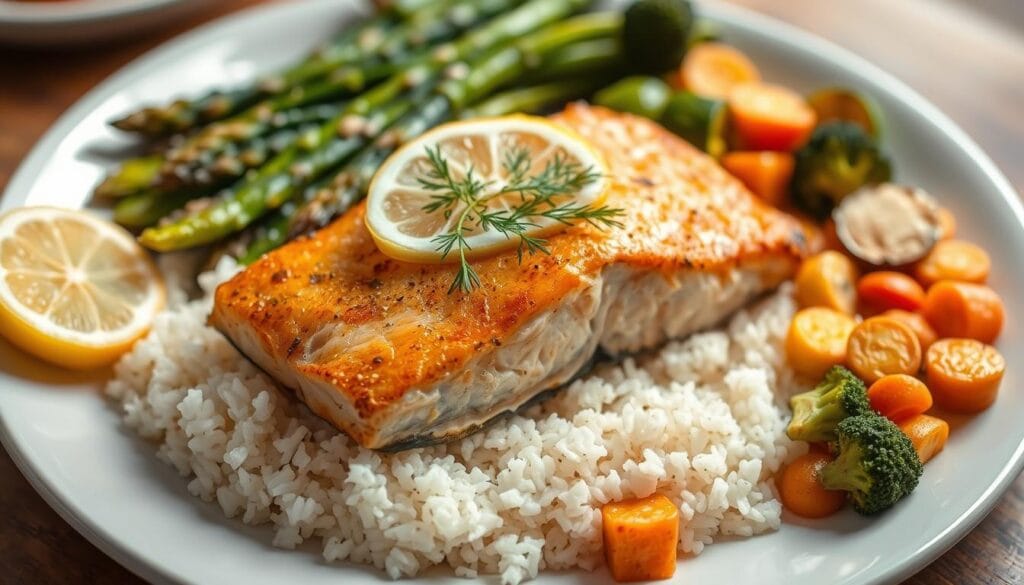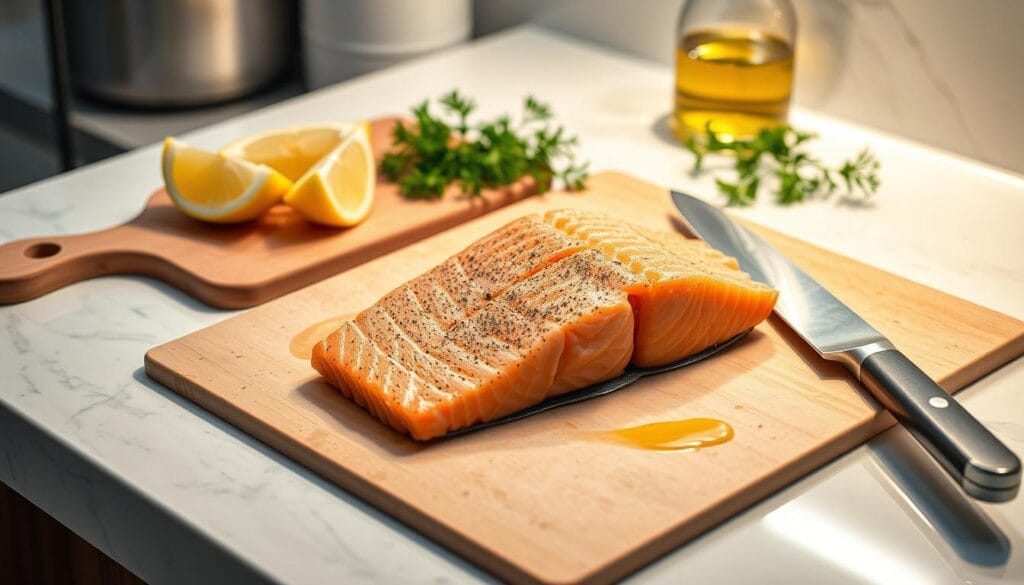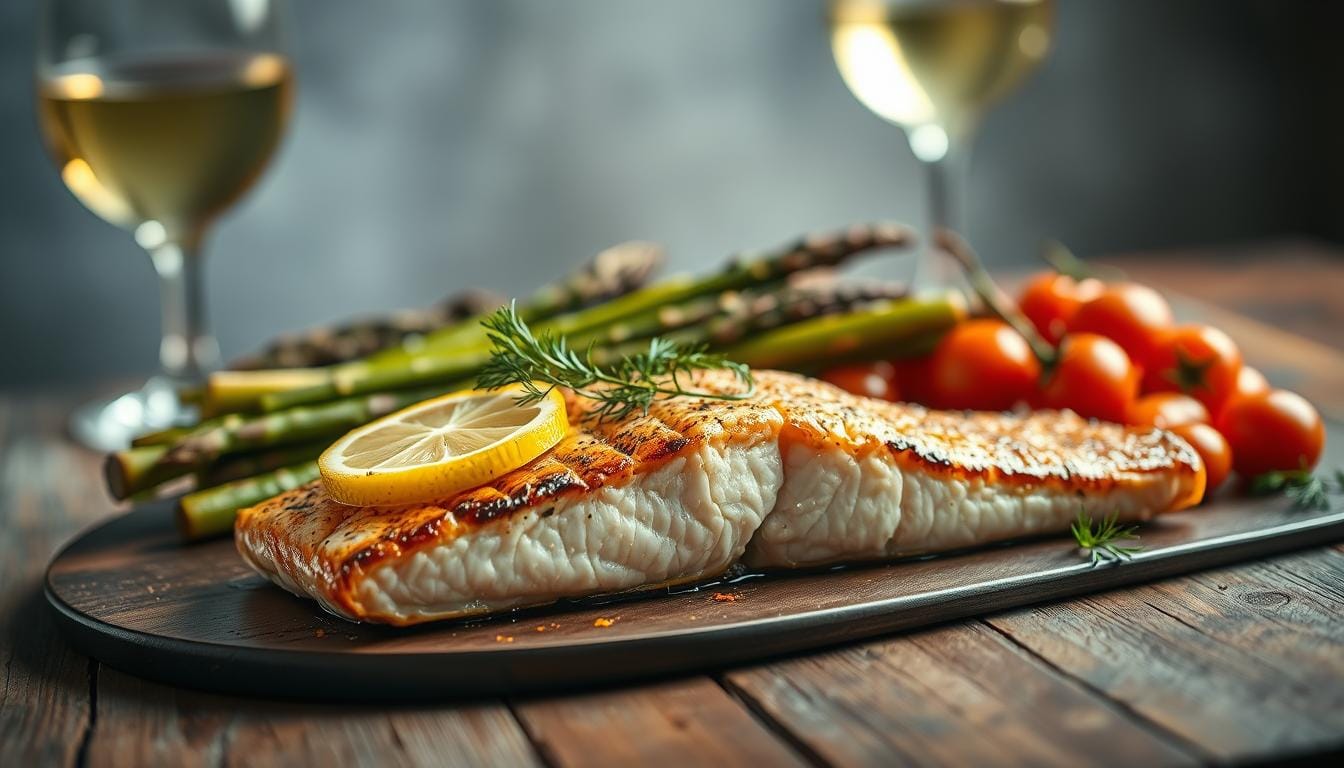After a long day, cooking dinner can feel like a chore. But, salmon can turn any weeknight meal into a special treat with just a little effort. An easy salmon recipe is more than just food. It’s about saving time and taking care of yourself without stress.
Table of Contents
Don’t worry if you’re not a pro in the kitchen. Cooking a quick salmon dinner is easy, no matter your schedule. Whether you’re busy at work, taking care of kids, or looking for healthy meals, salmon is perfect. You can try different ways to cook it, like in a skillet or in the oven, making meal planning a breeze.
Picture this: a healthy, tasty meal ready in under 30 minutes. Salmon is so versatile, you can try many flavors and cooking styles without needing to be a master chef. Each way of cooking brings its own special taste and texture, making your meals exciting and easy to make.
Learning a few basic salmon cooking techniques opens up a world of delicious dishes. This guide will show you how to make amazing salmon meals that are both impressive and simple to make.
Why Salmon Is the Perfect Choice for Quick Meals
Finding a healthy seafood meal that’s tasty and quick can be tough. Salmon is the perfect choice for those who are busy but want to eat well. It’s both nutritious and flavorful.
Health Benefits of Including Salmon in Your Diet
Salmon is a nutritional powerhouse. It has essential nutrients that are good for you. Here’s what you get from just one serving:
- 22 grams of high-quality protein per 3.5-ounce serving
- Rich in omega-3 fatty acids supporting heart and brain health
- Abundant in B vitamins for energy metabolism
- Mineral content including selenium and potassium
Time-Saving Benefits of Cooking Salmon
Salmon is a quick and easy choice for cooking. Most salmon dishes can be ready in just 10-15 minutes. It’s ideal for busy weeknights.
Versatility in Meal Planning
Salmon fits into many different dishes. You can grill, bake, or pan-sear it. It works well in:
- Salads
- Pasta dishes
- Tacos
- Breakfast omelets
Salmon makes meal planning easy and exciting. Its quick cooking, great nutrition, and versatility make it a standout choice.
Essential Kitchen Tools for Perfect Salmon Preparation
To make delicious baked salmon, you need the right tools. Both professional chefs and home cooks know that the right equipment makes a big difference. It turns simple salmon recipes into something amazing.
Here are the key tools you need for perfect salmon:
- Heavy-bottomed skillet (preferably cast iron)
- Baking sheets with rimmed edges
- Parchment paper or aluminum foil
- Reliable meat thermometer
A cast-iron skillet is a must-have for salmon. It cooks the salmon’s outside crispy and keeps the inside tender. Baking sheets help with oven cooking, making sure everything cooks evenly and cleaning up is a breeze.
| Tool | Purpose | Benefit |
|---|---|---|
| Cast Iron Skillet | Searing salmon | Crispy exterior, even heat |
| Meat Thermometer | Checking doneness | Ensures 145°F internal temperature |
| Parchment Paper | Baking protection | Non-stick surface, easy cleanup |
A meat thermometer is the most important tool for salmon. The USDA says to cook fish to 145°F (63°C) for safety and flavor. This tool helps avoid overcooking, which can make your salmon dry.
Invest in quality tools, and your salmon dishes will consistently impress!
Selecting and Storing Fresh Salmon
Choosing the right salmon is key for tasty homemade salmon recipes. Whether it’s a simple dish or a fancy meal, knowing how to pick and store your fish is important.
When you go shopping for salmon, you’ll find two main types: wild and farmed. Each has its own special qualities that can change how you cook and what you eat.
Wild vs. Farmed Salmon: Making the Right Choice
Wild salmon is often better for you. It has:
- Less contaminants
- More minerals
- Nutrients from its natural diet
Storage Tips for Maximum Freshness
Storing salmon right keeps it safe and tasty for your recipes. Here are some tips:
- Keep it in the fridge at 32°F (0°C)
- Eat it within 1-2 days
- Freeze at 0°F (-18°C) for up to 3 months
- Use airtight bags when freezing
Signs of Fresh Quality Salmon
Finding fresh salmon takes some eye for detail. Look for these signs:
- Bright, clear look
- Firm, moist flesh
- Shiny, metallic skin
- Mild, ocean smell
Learning about these selection and storage tips will make your salmon dishes even better. You’ll enjoy a great meal every time.
Easy Salmon Recipe – Basic Preparation Methods
Turning a simple salmon dish into a standout meal is easy. The secret is knowing the basic preparation techniques. These methods help bring out the fish’s natural flavors.
Begin by choosing top-quality salmon fillets. The way you prepare it greatly affects the taste and texture of your dish.
Essential Seasoning Techniques
To make a tasty salmon dish, start with the right seasoning. Here’s a simple way to boost your salmon’s flavor:
- Drizzle olive oil over the salmon fillets
- Sprinkle with salt and black pepper
- Add dried thyme for herbal notes
- Dust with garlic powder for extra flavor
Cooking Methods
You can choose from several ways to cook your salmon:
- Pan-Searing: Creates a crispy exterior
- Baking: Ensures tender, moist results
- Grilling: Adds a smoky flavor profile
Baking is great for beginners. Preheat your oven to 400°F. Place seasoned fillets on a lined baking sheet. Cook for 12-15 minutes until the fish flakes easily.
Pro tip: Always let your salmon rest for a few minutes after cooking to retain moisture and enhance flavor.
Don’t worry if cooking salmon seems daunting at first. With these basic methods, you’ll soon be cooking like a pro at home.
Flavor Combinations That Enhance Salmon
Turning your salmon into a masterpiece starts with layering flavors. It’s not just about cooking the fish. It’s about creating a meal that excites your taste buds.
Choosing the right flavors can make a simple dish into a memorable meal. Let’s dive into some ways to boost your salmon’s flavor.
Sweet and Savory Glazes
Sweet and savory glazes add magic to salmon by mixing different tastes. Try these:
- Brown sugar and soy sauce glaze
- Honey and Dijon mustard blend
- Maple syrup with garlic and lemon
Herb and Spice Magic
Fresh herbs and spices can turn your salmon into a showstopper. Try these flavor boosters:
- Dill and lemon zest for brightness
- Paprika and cumin for smoky depth
- Tarragon and black pepper for complexity
Asian-Inspired Marinades
Asian marinades bring exotic flavors to your salmon. A classic mix includes:
- Soy sauce
- Honey
- Fresh ginger
- Minced garlic
- Sesame oil
These marinades not only make the salmon taste better. They also add a unique blend of flavors that will wow your guests.
Pan-Seared Salmon Techniques
Learning to pan-sear salmon is key to a tasty dish. This method turns a simple fillet into a gourmet meal with little effort. The secret to success is in the prep and managing the heat.
Begin by picking a fresh salmon fillet and drying it with paper towels. This step is vital for a crispy outside and a golden crust.
- Choose a heavy-bottomed skillet for even heat distribution
- Use high-heat cooking oils like avocado or grapeseed oil
- Season the salmon with salt and pepper just before cooking
For the best pan-seared salmon, timing and temperature are crucial. Heat your skillet until it’s scorching hot. Then, add a thin layer of oil. Place the salmon skin-side down and cook without moving it for about 4-5 minutes.
| Salmon Thickness | Cooking Time (Skin Side) | Cooking Time (Flesh Side) |
|---|---|---|
| 1/2 inch | 3-4 minutes | 1-2 minutes |
| 1 inch | 4-5 minutes | 2-3 minutes |
Check for doneness by looking for visual signs: the salmon should be opaque and flake easily. A well-cooked salmon is moist, tender, and slightly pink in the center for medium-rare.
Oven-Baked Salmon Methods
Learning to make delicious baked salmon is all about the right techniques and temperatures. Oven-baking is a simple way to make tasty and healthy homemade salmon recipes.
Perfecting Your Oven-Baked Salmon Technique
Cooking salmon in the oven ensures even heat and easy prep. The secret is to control the temperature and cooking time well.
Temperature Guidelines for Perfect Doneness
Different doneness levels need specific internal temperatures:
- Medium-rare: 120°F (49°C)
- Medium: 125°F (52°C)
- Well-done: 140°F (60°C)
Cooking Times for Different Salmon Thicknesses
The thickness of your salmon affects how long it cooks. Here’s a simple rule:
- 4-6 minutes per half-inch of fillet thickness
- 1-inch thick fillet: 8-12 minutes in the oven
Here are some tips for moist, tasty baked salmon:
- Preheat the oven before cooking
- Use parchment paper to prevent sticking
- Baste with marinade for extra flavor
- Use a meat thermometer for precise doneness
The USDA recommends an internal temperature of 145°F for safe salmon consumption.
By following these tips, you’ll make homemade salmon recipes that will wow your family and friends.
Grilled and Broiled Salmon Preparations
Turning an easy salmon recipe into a tasty dish needs skill in grilling and broiling. These methods cook the fish fast, making a crispy outside and keeping it juicy inside. They also bring out the fish’s rich flavor.
Grilling salmon adds smoky flavors that make your meal better. To grill well, remember these tips:
- Choose thick salmon fillets for the best grilling results
- Marinate the fish for 30 minutes to add more flavor
- Heat your grill to medium-high before grilling
- Use a fish basket to stop it from sticking
Broiling is another great way to make delicious salmon. It’s all about placing your oven rack right and watching the time.
| Cooking Method | Cooking Time | Temperature |
|---|---|---|
| Grilling | 4-6 minutes per side | Medium-high heat |
| Broiling | 6-10 minutes total | High broiler setting |
Pro tip: Always aim for an internal temperature of 145°F to guarantee perfectly cooked salmon.
“The secret to great salmon is respecting its delicate nature while adding bold flavors.” – Culinary Expert
Learning these techniques will help you make meals that wow your family and friends. You’ll turn simple ingredients into amazing dishes.
Quick Salmon Side Dish Pairings
Making a healthy seafood meal is more than just cooking salmon. The right side dishes can turn your meal into a feast for your taste buds and body.

Choosing the perfect sides for salmon can make your meal stand out. Your sides should match the fish’s flavor, add nutrition, and look good too.
Vegetable Combinations That Shine
Vegetables add color and texture to your salmon dish. Try these great pairings:
- Roasted Brussels sprouts with a light olive oil drizzle
- Grilled asparagus with lemon zest
- Sautéed spinach with garlic
- Colorful Mediterranean salad with fresh herbs
Grain and Starch Alternatives
Pair your salmon with hearty grains for a complete meal:
- Quinoa pilaf with fresh herbs
- Cauliflower mash for a low-carb option
- Wild rice salad with toasted nuts
- Couscous with fresh parsley
“The right side dish can transform a good meal into an unforgettable dining experience.” – Culinary Expert
Remember, your sides should complement the salmon’s flavor. Pick ingredients that make your plate balanced, nutritious, and enjoyable.
Make-Ahead Salmon Meal Prep Ideas
Creating a quick salmon dinner is easy. Meal prepping salmon dishes saves time and ensures tasty meals all week. With a few simple steps, you can turn your simple salmon dish into many convenient meals.
Here are some great make-ahead salmon meal prep ideas:
- Baked Salmon with Roasted Vegetables
- Salmon and Quinoa Bowls
- Crispy Salmon Patties
- Salmon Salad Containers
When prepping salmon for meal prep, remember these storage tips:
- Refrigerate cooked salmon within two hours of cooking
- Store in airtight containers
- Consume refrigerated salmon within 3-4 days
- Freeze for up to 3 months if needed
“Meal prepping salmon doesn’t mean sacrificing flavor or quality” – Professional Chef
Reheating is key to keep salmon’s taste and texture. Use a low-temperature oven or microwave with a cover to avoid drying. For salmon patties, pan-frying can restore their crispy exterior.
Pro tip: Keep dressings and sauces separate when meal prepping. This keeps your meals fresh and tasty all week.
Common Salmon Cooking Mistakes to Avoid
Learning how to cook salmon fillets can make your dish go from okay to outstanding. Many people make simple mistakes that ruin their seafood meal.
Here are the most critical errors to avoid when preparing salmon:
- Overcooking the Salmon: The biggest mistake that makes fish dry and tough. Use a food thermometer to check the internal temperature. It should be 125°F for medium-rare or 140°F for medium.
- Skipping the Drying Process: Always pat your salmon fillet dry with paper towels before cooking. This step is key for a crispy, well-seared exterior by removing excess moisture.
- Removing the Skin: Keep the skin on during cooking. It protects the delicate flesh, prevents drying, and can create a delightfully crispy texture when properly prepared.
When cooking salmon, remember these key techniques:
- Let the salmon rest for 5 minutes after cooking to redistribute juices
- Season carefully without overwhelming the fish’s natural flavor
- Flip the salmon only once during cooking to maintain its delicate texture
By avoiding these common pitfalls, you’ll improve your salmon cooking skills. You’ll make dishes that rival those from restaurants. Practice these tips, and you’ll soon be confident in preparing an easy salmon recipe that wows everyone.
Time-Saving Tips for Weeknight Salmon Dinners

Making a quick salmon dinner is easy. Busy cooks can turn healthy meals into simple weeknight options. Just a few tips can make a big difference.
Getting ready is crucial for quick salmon cooking. Here are some tips to make your meal prep faster:
- Pre-season salmon fillets in advance
- Store seasoned fish in refrigerator for instant cooking
- Use fast cooking techniques like broiling or pan-searing
- Prep side dishes before cooking salmon
One-pan salmon meals are perfect for weeknights. They make cooking and cleaning up easy. You can roast veggies with your salmon for a full meal in under 30 minutes.
| Cooking Method | Total Time | Difficulty |
|---|---|---|
| Pan-Seared | 15 minutes | Easy |
| Broiled | 10 minutes | Very Easy |
| Sheet Pan | 25 minutes | Easy |
Turn leftover salmon into exciting next-day meals. Use it in salads, wraps, or pasta for quick lunches. It saves time and reduces waste.
Pro tip: Always keep salmon fillets in your freezer for instant healthy meal solutions!
Conclusion
Trying an easy salmon recipe can change how you cook at home. It makes quick and tasty salmon dishes possible. This protein is great for those who want healthy, delicious meals fast.
By learning different ways to cook salmon, like pan-searing or oven-baking, you’ve found it’s perfect for weeknight dinners. The many flavors and cooking methods keep your meals exciting and fulfilling. This shows that eating healthy doesn’t have to be hard or take a lot of time.
Exploring salmon cuisine opens up many cooking possibilities. With practice, you’ll get better at picking, storing, and cooking this healthy fish. Salmon is perfect for both new and experienced cooks, offering endless chances to make tasty, healthy meals that impress everyone.
Begin trying out these cooking methods and make salmon a regular part of your meals. Your knowledge of tasty salmon dishes will spark creativity and make every meal a fun experience.
FAQ
How long does it take to cook salmon?
Cooking salmon takes 15-20 minutes. Pan-searing takes 8-10 minutes. Oven-baking needs 12-15 minutes, depending on the fillet’s thickness. Grilling takes 4-6 minutes per side for a perfect piece.
What are the healthiest ways to cook salmon?
Baking, poaching, steaming, and grilling are the healthiest methods. They use little fat and keep nutrients and omega-3s intact. Avoid deep-frying, which adds calories and reduces nutrients.
Can I freeze fresh salmon?
Yes, you can freeze fresh salmon. Wrap it tightly in plastic or use an airtight bag. It can stay frozen for up to 3 months. Thaw it in the fridge overnight for the best taste and texture.
How do I know when salmon is fully cooked?
Salmon is cooked when it reaches 145°F (63°C). It should be opaque and flake easily with a fork. The center should be slightly translucent and moist. Don’t overcook, as it will dry out.
What are the best seasonings for salmon?
Great seasonings include lemon, dill, garlic, black pepper, and herbs like thyme and parsley. Asian flavors like soy sauce, ginger, and sesame oil are also great. A simple mix of olive oil, salt, and black pepper enhances its flavor.
Is wild salmon better than farmed salmon?
Wild salmon tastes better and has fewer contaminants. It’s richer in minerals and has a better omega-3 to omega-6 ratio. Farmed salmon is cheaper and more available. Both are nutritious if from good sources.
How can I prevent salmon from sticking to the pan?
Make sure your pan is hot before adding salmon. Use a non-stick skillet or cast-iron pan. Add a thin layer of oil like avocado or grapeseed oil. Pat the salmon dry and don’t move it too much while searing.
Can I meal prep salmon dishes?
Absolutely! Salmon is perfect for meal prep. Cook it and store it in the fridge for 3-4 days. Prepare patties, salad bowls, or fillets for easy reheating. Use airtight containers and reheat gently to keep it moist.


